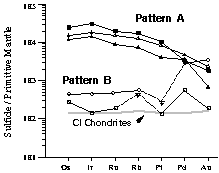Highly Siderophile Elements in Mantle Sulfides: In-situ LAM-ICPMS analysis
O. Alard1, W.L. Griffin1, J.P. Lorand2, S. Jackson1 and S. Y. O'Reilly2
1GEMOC Macquarie
2Laboratoire de Mineralogie, Museum National d'Histoire Naturelle, ESA CNRS n°7058, 61 Rue Buffon, 75005 Paris, France.
The geochemistry of the siderophile and chalcophile elements potentially carries large amounts of information on processes in mantle-derived rocks. In particular, the Platinum Group Elements (PGE), which are classified with Au and Re as highly sideophile elements (HSE) may be even more useful than the more commonly used REE. Sulfide phases are thought to be the main hosts for the HSE in mantle rocks; PGE contents on the order of tens of ppm have been reported for sulfide inclusions in peridotite-paragenesis diamonds [1] and for sulfide fractions from the Lherz orogenic massif [2]. However these two studies have yielded contrasting chondrrite-normalised PGE patterns; sulfides in diamond have high IPGE (Os,Ir and Ru) contents and Pd/IrN <1, and "massif" sulfides have lower IPGE contents and Pd/IrN 1.
We have determined the HSE (PGE +Au) contents of single mantle sulfide grains using a custom-built Nd:YAG UV laser-ablation microprobe linked to a Perkin Elmer Sciex ELAN6000 ICPMS. We have investigated peridotite xenoliths in alkali basalts from Eastern Australia and the Massif Central (France); kimberlite-hosted garnet peridotites (South Africa); orogenic peridotites from Lherz (Pyrenees, France) and an abyssal peridotite from the Kane area (Atlantic).
The PGE contents of the sulfides are highly variable, e.g. Os ranges from 0.5 to 100 ppm and Pd from 0.4 to 83 ppm. The concentrations of IPGE in sulfide are roughly inversely correlated with whole rock S content. None of the PGE patterns of sulfides, whether enclosed in other phases or interstitial, is chondritic. Mantle-normalised PGE patterns can be divided into two basic types: Pattern A (figure 1) displays high IPGE content and decreasing normalised contents toward Pd and Au, leading to Pd/IrN <1. Pattern B (figure 1) is characterised by low IPGE contents and Pd/IrN 1. The two patterns can be observed in different sulfide grains in the same sample. Sulfides having pattern A are MSS and are generally enclosed in primary silicate phases (e.g. olivine, garnet); they occur in all sample types. The B pattern is found in interstitial sulfides, which commonly are Cu-rich compared to the silicate-enclosed ones from the same sample. For instance, in sample AR-10 (New England, Australia), which has 330 ppm of S and Al2O3ª 2.5%, angular sulfides within metasomatic patches have typical B patterns.
Both patterns may display negative Pt anomalies (Pt/PdN<1
and Pt/RuN<1). These anomalies can be very pronounced as
in lherzolite 84-1 from Lherz which has Pt/PdN and Pt/RuN
as low as 0.02 and 0.04, respectively. However, the whole rock Pt/PdN
and Pt/RuN are 0.5, 0.5 respectively [3], and the discrepancy
may imply that Pt is hosted by a phase(s) other than sulfide. We have occasionally
observed Pt peaks at the begining or end of sulfide ablation runs in serpentinized
rocks, suggesting that Pt may occur as discrete phase(s) at the margins
of sulfide grains, perhaps within altered sulfide or in silicates. However,
we have not yet observed any nugget effect for PGEs other than Pt in mantle
sulfides (cf [4-5]), even in the most PGE-rich ones. This suggests that
PGEs are highly soluble in base metal sulfides under mantle conditions.

Figure 1: Primitive-mantle normalised PGE patterns. Primitive
mantle and CI chondrite values are from [6]
On the basis of petrographic observations and experimental work [e.g. 7] we interpret sulfides with A patterns as residual MSS while sulfides displaying B patterns may represent trapped sulfide liquids. The complementary nature of these two patterns suggests that they are related through a single process, the partial melting of a "primitive" sulfide with a chondritic pattern: A sulfides represent the restite while B sulfides are related to the partial melt. Since many of the mantle samples studied here display both patterns, we suggest that many of the "typical" chondritic mantle patterns found in whole-rock PGE analyses may reflect a mixing between several sulfide generations. In-situ analysis is required to understand these patterns.
References:
[1] Bulanova G.P. et al. (1996) Geochim Cosmochim Acta, 124,
111-125.
[2] Pattou L et al. (1996), Nature, 379, 712-715.
[3] Lorand J.P. et al. (1999) J. Petrol., in press.
[4] Tredoux et al. (1997) EAG workshop 97.
[5] Balhaus C. (1997) EAG workshop 97.
[6] McDonough & Sun (1995) Chem. Geol.,120, 225-253.
[7] Li et al. (1996), Geochim Cosmochim Acta, 60,1231-1238.

 GEMOC ARC National Key Centre
GEMOC ARC National Key Centre